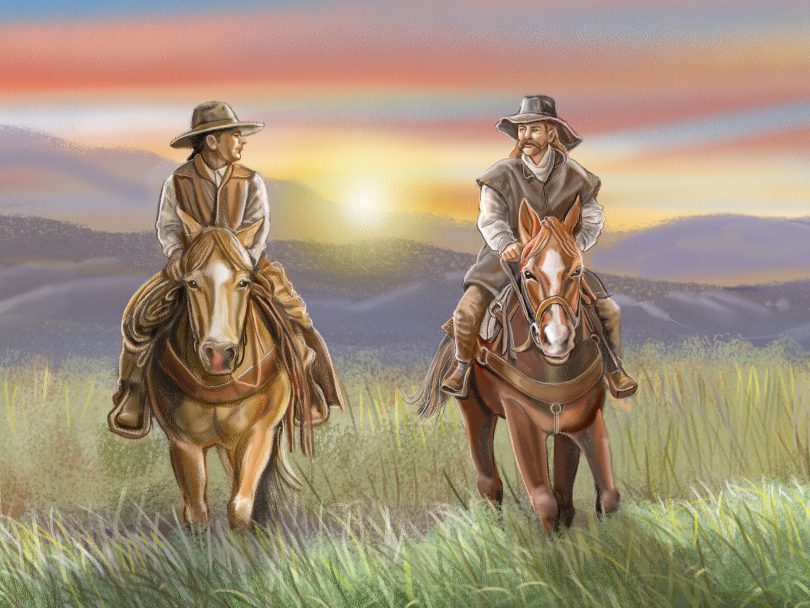By Martin Mulcahey, Illustrations by Cathy Morrison –
Buried gold. Lost loot. Payroll from a bygone era. All of these treasures and more lie hidden in Colorado, according to old stories that have been passed on, shared and now exist almost as legends.
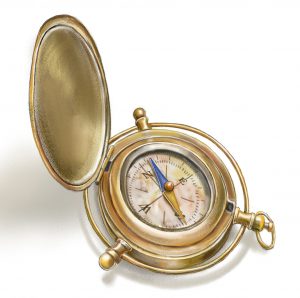 It surprises many that there is supposedly so much buried treasure in Colorado that time and fading memories conspire to conceal. But, multitudes of books and television shows are dedicated to helping find these hidden fortunes. Join the search with a little research, some sturdy hiking boots and a good metal detector. (Just remember to get permission if your search takes you onto private property.)
It surprises many that there is supposedly so much buried treasure in Colorado that time and fading memories conspire to conceal. But, multitudes of books and television shows are dedicated to helping find these hidden fortunes. Join the search with a little research, some sturdy hiking boots and a good metal detector. (Just remember to get permission if your search takes you onto private property.)
Here are four fortunes boasting the greatest historical appeal and monetary reward. Keep in mind, some locations are remote and can be challenging to navigate. To start, it is best to establish a base camp in a nearby town and plan day excursions from the comfort of a cool and Wi-Fi enabled room. Or, the more ambitious may want to pack a tent, sleeping bags and supplies to revel in a more immersive treasure hunt.
Virginia Dale Stage Robbery
The year was 1863 and the stagecoach near tiny Virginia Dale Station just south of what is now the Wyoming border in today’s Larimer County was robbed. A wagon containing an army payroll of $60,000 (over $2.5 million today) in gold was robbed by six gunmen. The loot, which was months of back pay for soldiers at Fort Sanders near today’s Laramie, Wyoming, consisted mostly of freshly minted $10 and $20 double eagle coins.
The outlaws were quickly set on by a motivated cavalry unit dispatched from the Wyoming territory. They had no choice but to quickly bury the gold with the hope of circling back after losing the cavalry.
It was not their destiny, as the running shoot-out culminated violently. Five thieves were killed in subsequent skirmishes, leaving the location of the loot a mystery to this day. The only evidence that the payroll existed was an empty strongbox found abandoned beside a creek bed.
The shadowy sixth man and supposed ringleader of the bandits was rumored to be notorious Jack Slade. He, not coincidentally, worked as a station manager for the company that was robbed. There was never enough evidence to bring Slade before a jury, but the U.S. Army and detectives hired by the stage company surveilled Slade after his firing. Any hope of catching Slade retrieving the gold was dashed when Slade was hanged in Montana a year later for unrelated crimes.
The robbery took place one mile from Virginia Dale Station, at Long View Hill, with the gunmen reportedly riding west toward moderately wooded foothills. The area teemed with outlaws, as the landscape provided natural hideout places, and nearby Table Mountain was the site of a cabin locals called “Robbers Roost.” Situated a couple miles northeast of Virginia Dale Station, it sat atop a steep cliff with shale rim providing the inhabitants advanced warning of approaching lawmen.
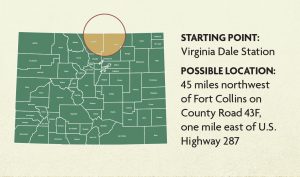 Today, Virginia Dale Station is an off-the-grid destination for western history aficionados. The old Overland Trail stage station was added to the National Register of Historic places in 1985. Weather-beaten but standing strong in defiance of time, it is located 45 miles northwest of Fort Collins on County Road 43F (an easily navigable dirt road), one mile east of U.S. Highway 287. It is the starting point for treasure seekers looking to unearth Slade’s lost loot.
Today, Virginia Dale Station is an off-the-grid destination for western history aficionados. The old Overland Trail stage station was added to the National Register of Historic places in 1985. Weather-beaten but standing strong in defiance of time, it is located 45 miles northwest of Fort Collins on County Road 43F (an easily navigable dirt road), one mile east of U.S. Highway 287. It is the starting point for treasure seekers looking to unearth Slade’s lost loot.
Arapaho Princess Treasure
Somewhere near the rocky outcrops of Las Animas in southern Colorado, fleeing Spanish pioneers hid a large cache of gold bars. The Apishapa Valley of the early 1800s was not a welcoming environment. Even Native American people called the valley “Stinking Water” because of the river’s periods of stagnation. However, if people took the time to dig below the surface, the valley yielded abundant veins of gold. This attracted Spanish prospectors and accompanying settlers, who came to mine the natural resources of what is now Walsenburg.
For three years, the Spanish lived in close contact with the indigenous Arapaho tribe, reliant on them as laborers and military allies against the hostile Ute tribe. Around 1823, a procession that included eight gold-laden mules departed for Mexico City. Leading it was an experienced Spanish lieutenant, Carlos Montenegro. Shortly after departing, the Spanish were set upon by Ute warriors. Sure of their demise if they didn’t put some distance between them and the warriors, those in the caravan buried the heavy horde of gold weighing them down. The decision was made too late and only three men escaped to safety in Santa Fe.
The wounded trio vowed to return. Lieutenant Montenegro was motivated by something other than gold. He had married an Arapaho chieftain’s daughter who bore him a child. Still, it took Montenegro nearly a decade to find his way back, only to find his wife had died of fever. A concerned father, Montenegro tried to convince his 13-year-old daughter to return to Spain. He also shared the story of the buried gold. The pious Montenegro became convinced the gold was cursed, and native folklore warns of rattlesnakes protecting the treasure.
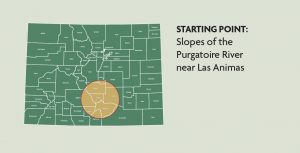 The gold is said to be buried not far from a memorable grouping of boulders the Spanish called La Muñeca (The Doll), which refers to the shape of a rocky outcrop standing 30 feet high. The unique formation is supposedly on the northwest slope of West Spanish Peak, near La Veta, a short drive from U.S. Highway 160.
The gold is said to be buried not far from a memorable grouping of boulders the Spanish called La Muñeca (The Doll), which refers to the shape of a rocky outcrop standing 30 feet high. The unique formation is supposedly on the northwest slope of West Spanish Peak, near La Veta, a short drive from U.S. Highway 160.
Montenegro’s daughter believed her father’s story indicated the gold was buried some place above the Purgatoire River, eight to 10 miles east of Las Animas. Contradictory historical records place the treasure nearer East Spanish Peak, which is accessible via Aguilar off Interstate 25. The majority of treasure hunters begin their search on the slopes of the Purgatoire River and work their way west.
The Lost Loot of the Reynolds Gang
As the Civil War engulfed America, unscrupulous men cloaked themselves in flags for profit. That was the case with the Reynolds gang, a party of Confederate sympathizers who stashed $100,000 from bank, mine, stagecoach and ranch robberies. It started with the two Reynolds brothers, John and James, who planned attacks on gold mines in Fairplay and South Park to finance the Confederate secession. It quickly degenerated into acts of self-enrichment.
The 23-man cadre’s (whittled down to nine at the end) raids took place in the waning years of the Civil War, encompassing the marginally pro union Colorado territory between Cañon City and Como. They wreaked havoc for a short but intense period in the spring of 1864 and met little resistance initially. However, when confronted by a large posse, as well as the volunteer 3rd Colorado Infantry Regiment, the gang found escape paths to Confederate-held regions cut off.
Rather than allowing their plunder to fall into the hands of their pursuers, the brothers buried the treasure somewhere near Kenosha Pass, Fairplay, Como or Conifer close to Deer and Elk creeks. Myriad stories and crimes are associated with the Reynolds gang, making it difficult to separate truth from fanciful fiction, but it is a historical fact that only the two brothers escaped Colorado. Ringleader John Reynolds fled home to New Mexico, where he was mortally wounded in a gunfight two years later. On his deathbed, John drew a map revealing the location of the loot to fellow outlaw Albert Brown.
With map in hand, Brown traveled to South Park where, to his horror, many of the landmarks Reynolds drew on the map had been destroyed by a wildfire. An out-of-print 1897 book Hands Up; or Thirty-Five Years of Detective Life in the Mountains and on the Plains by General D. J. Cook theorizes that the treasure is hidden in Hall Valley near Grant. Local historians are not as sure, believing it is buried closer to Deer Creek about 5 miles from Shaffers Crossing near U.S. Highway 285.
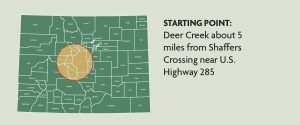 The book’s most revealing passage quotes a dying John Reynolds: “You go above Geneva Gulch a little ways, and you’ll find where one of our horses mired down and we had to leave it here. At the head of the gulch, you turn to the right and follow a mountain around a little farther. And just above the head of Deer Creek, you’ll find an old prospector’s shaft running back into the mountain at about timberline. It’s back there in the hole, partner. We walled the hole up with stones and stuck a butcher knife into a tree about 4 feet from the ground, broke the handle off and left it pointing to the mouth of the hole.”
The book’s most revealing passage quotes a dying John Reynolds: “You go above Geneva Gulch a little ways, and you’ll find where one of our horses mired down and we had to leave it here. At the head of the gulch, you turn to the right and follow a mountain around a little farther. And just above the head of Deer Creek, you’ll find an old prospector’s shaft running back into the mountain at about timberline. It’s back there in the hole, partner. We walled the hole up with stones and stuck a butcher knife into a tree about 4 feet from the ground, broke the handle off and left it pointing to the mouth of the hole.”
Cave of the Golden Jesus
One of America’s most fantastical undiscovered treasures, the Golden Jesus, is the most difficult to pinpoint to a region since its origin story dates back to the 1770s. Legend has it that somewhere in southwestern Colorado there is a solid gold statue cast in the likeness of baby Jesus. Touted to stand nearly 4 feet tall, it is hidden in a cliff-side cave or crevice in the La Plata mountains. If found, it would be worth millions in gold alone.
The icon was hidden by Spanish explorers returning from the La Sal Mountains in Utah. They planned to winter in Santa Fe as the deadly cold overtook the Rockies. Helming the caravan was a small military escort leading miners, blacksmiths, cooks and simple laborers.
The journey began under an ominous cloud. The workers were upset over paltry allotments of gold from their arduous mining. Sensing tension, the soldiers smelted hundreds of small gold ingots, recasting them into one large figure to prevent a couple of rogues from stealing the lighter ingots.
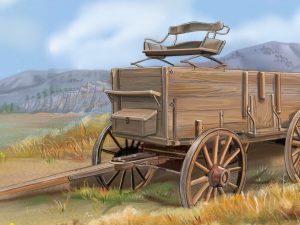 The Golden Jesus, weighing several hundred pounds, had to be hauled in a specially built wagon. This limited the expedition’s progress to 10 miles a day. Given the slow passage, the military commander split his caravan, sending the workers ahead with a detachment of soldiers. What they had not noticed was a Native American raiding party shadowing them. The natives saw the division of forces as an opportunity to attack. The next morning the band attacked, killing a majority of the Spaniards. A ranking officer ordered four men to hitch up the wagon carrying the gold icon and attempt to get away.
The Golden Jesus, weighing several hundred pounds, had to be hauled in a specially built wagon. This limited the expedition’s progress to 10 miles a day. Given the slow passage, the military commander split his caravan, sending the workers ahead with a detachment of soldiers. What they had not noticed was a Native American raiding party shadowing them. The natives saw the division of forces as an opportunity to attack. The next morning the band attacked, killing a majority of the Spaniards. A ranking officer ordered four men to hitch up the wagon carrying the gold icon and attempt to get away.
The natives focused their attack on the main unit with its supplies and horses, and the wagon with the Golden Jesus got away. Reportedly 4 miles from the scene of the attack, the soldiers recognized escape was impossible with their large cargo. They jettisoned the statue to facilitate their escape. Earliest translated accounts contend it was hidden in a small cave, while modern researchers theorize a large crevice located on a bluff conceals the treasure.
Four soldiers ultimately escaped the natives and reported the demise of their comrades when arriving in Santa Fe. The fort lacked a large enough garrison to pursue the natives, but the promise of a lucrative reward enticed 30 Santa Feans to attempt to bring back the Golden Jesus. They found the entire caravan killed and horribly mutilated. Just as shockingly, an even larger party of Utes had gathered to engage them. A second bloody retreat ensued, convincing all that the dangers outweighed any profit.
Accounts of what became of the soldiers vary. Some say all four returned to Spain, while others claim two died in a final attempt to retrieve the golden icon.
Tales recounting unsuccessful forays, by Spaniards and locals to find the treasure abound. The closest anyone seems to have come was in 1873. A wagon train from Illinois happened on an emaciated prospector wandering aimlessly near present-day Hesperus.
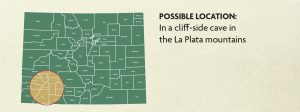 The delirious man told of finding a golden statue too heavy to move, so he walled up the entrance with even more stones to hide it until his return. Incapacitated by his illness, the frontiersman died before the settlers reached a doctor. The Golden Jesus was lost again and awaits discovery by a lucky treasure hunter, as do all of these lost riches.
The delirious man told of finding a golden statue too heavy to move, so he walled up the entrance with even more stones to hide it until his return. Incapacitated by his illness, the frontiersman died before the settlers reached a doctor. The Golden Jesus was lost again and awaits discovery by a lucky treasure hunter, as do all of these lost riches.
They are out there somewhere, reminders of the Centennial State’s long history.
Writer Martin Mulcahey is an experienced freelancer with a love for Colorado and its history.

